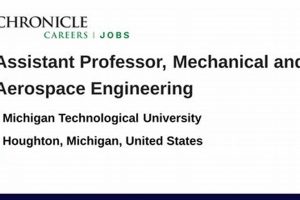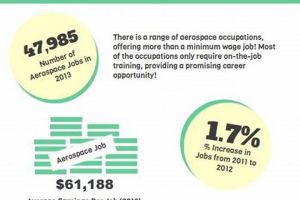This career field encompasses a range of non-military positions focused on the maintenance, repair, and operation of specialized tools and machinery used to support aircraft and spacecraft on the ground. Examples include servicing carts, power units, test equipment, and lifting devices vital for pre-flight checks, post-flight maintenance, and overall operational readiness.
The significance of this sector lies in ensuring the safety and efficiency of air and space travel. Well-maintained ground support systems directly contribute to on-time departures, reduced downtime for aircraft, and a safe working environment for technicians and flight crews. Historically, as aviation and space technology have advanced, so too has the sophistication and complexity of the equipment required to support them, creating a continuous demand for skilled professionals.
The following sections will delve into the specific roles available, required qualifications and training, potential career pathways, and the overall outlook for individuals seeking opportunities in this essential area of the aerospace industry.
This section provides essential guidance for individuals pursuing employment in the civilian aerospace ground equipment field. These insights are designed to enhance preparedness and improve prospects in this competitive industry.
Tip 1: Emphasize Technical Proficiency: Demonstrate a strong understanding of mechanical, electrical, and hydraulic systems. Prioritize certifications and training programs that validate expertise in relevant areas.
Tip 2: Acquire Specialized Training: Seek out training specific to aerospace ground support equipment. Many manufacturers offer courses on their equipment’s operation, maintenance, and repair.
Tip 3: Highlight Relevant Experience: Focus on experience with similar equipment in other industries, such as automotive or heavy machinery. Clearly articulate how transferable skills can benefit the aerospace sector.
Tip 4: Develop Problem-Solving Skills: Ground equipment maintenance often requires troubleshooting complex issues under pressure. Provide examples of successful problem-solving experiences in past roles.
Tip 5: Prioritize Safety Consciousness: Aerospace environments demand strict adherence to safety protocols. Emphasize a commitment to safety and a proven track record of following procedures meticulously.
Tip 6: Build a Professional Network: Attend industry events, join professional organizations, and connect with individuals working in the field. Networking can provide valuable insights and potential job leads.
Tip 7: Research Potential Employers: Understand the specific equipment used by different aerospace companies or facilities. Tailor applications and interview responses to demonstrate knowledge of their operations.
Tip 8: Obtain Relevant Certifications: Explore certifications related to specific equipment types or maintenance procedures. These credentials can significantly enhance credibility and marketability.
Adherence to these tips can significantly improve the likelihood of securing a rewarding career in this vital segment of the aerospace industry. A proactive approach to skills development and networking is essential for long-term success.
The subsequent sections will explore the long-term career outlook and the evolving technologies shaping this field.
1. Maintenance
Maintenance is a foundational pillar within civilian careers focused on aerospace ground equipment. The integrity and reliability of this specialized machinery directly impact the safety and efficiency of aircraft and spacecraft operations. A robust maintenance program ensures optimal performance and minimizes downtime, crucial for meeting stringent operational demands.
- Preventive Maintenance Programs
This involves scheduled inspections, servicing, and component replacements based on time intervals or usage metrics. Real-world examples include regular lubrication of hydraulic systems, calibration of test equipment, and replacement of worn tires on aircraft towing vehicles. Effective preventive maintenance minimizes unexpected failures and extends the operational life of equipment.
- Corrective Maintenance Procedures
This addresses unscheduled repairs and troubleshooting of equipment malfunctions. Technicians diagnose issues using diagnostic tools, consult technical manuals, and perform repairs according to established procedures. An example would be repairing a faulty generator in a ground power unit, ensuring that aircraft systems can be tested and powered while on the ground.
- Component Overhaul and Refurbishment
This entails the complete disassembly, inspection, repair, and reassembly of major equipment components. This may involve hydraulic pumps, engine components, or electrical control systems. The overhaul process restores the component to its original performance specifications, offering a cost-effective alternative to complete equipment replacement.
- Adherence to Regulatory Standards
Maintenance activities must comply with regulations set by aviation authorities and industry standards. These standards dictate procedures, documentation, and technician qualifications. Failure to comply can result in operational delays, fines, or even safety hazards. Accurate record-keeping and adherence to prescribed methods are essential for maintaining regulatory compliance and ensuring operational integrity.
In conclusion, the effective execution of maintenance procedures is paramount in civilian positions related to aerospace ground equipment. By prioritizing preventive measures, addressing corrective actions promptly, adhering to regulatory standards, and engaging in component overhaul, the sector ensures the continued reliability and performance of vital support systems. This directly translates to enhanced safety, operational efficiency, and overall success in air and space operations.
2. Operation
The efficient and safe operation of specialized equipment constitutes a critical function within civilian aerospace ground support positions. Competent operation directly impacts the turnaround time of aircraft, the integrity of spacecraft preparation, and the overall effectiveness of ground-based activities. Adherence to strict operational protocols is paramount in this environment.
- Equipment Handling and Positioning
This facet involves the precise maneuvering and placement of equipment in relation to aircraft or spacecraft. Examples include the accurate positioning of passenger loading bridges, the safe attachment of tow bars for aircraft movement, or the careful alignment of fueling trucks with aircraft fuel ports. Incorrect handling can lead to damage to equipment, aircraft, or personnel, resulting in costly delays and potential safety hazards.
- System Activation and Monitoring
This includes initiating and overseeing the performance of ground support systems, such as ground power units, air conditioning units, or hydraulic test stands. Operators are responsible for verifying system parameters, monitoring for anomalies, and adjusting settings to meet specific operational requirements. Real-world implications involve ensuring a stable power supply to aircraft systems during maintenance or providing precise environmental control within a spacecraft payload processing facility.
- Emergency Procedures and Response
Operators must be trained to respond effectively to emergency situations, such as equipment malfunctions, power outages, or fuel spills. This involves following established procedures, activating safety systems, and communicating with relevant personnel. An example would be the immediate shutdown of a fuel pump in the event of a fuel leak or the activation of emergency braking systems on a mobile crane during an instability event.
- Documentation and Record-Keeping
Accurate documentation of operational activities is essential for tracking equipment usage, identifying potential issues, and ensuring accountability. Operators are responsible for maintaining logs of system performance, recording maintenance activities, and documenting any deviations from standard operating procedures. This documentation serves as a valuable resource for maintenance personnel and helps to improve overall operational efficiency.
In conclusion, the “Operation” aspect of civilian aerospace ground equipment roles encompasses a range of critical skills and responsibilities. From precise equipment handling to emergency response, operators play a vital role in ensuring the safe and efficient execution of ground support activities. Their competence directly translates to improved aircraft turnaround times, enhanced spacecraft preparation, and a safer working environment for all personnel involved. Accurate documentation further contributes to long-term operational effectiveness and continuous improvement.
3. Safety
The connection between safety and civilian positions involving aerospace ground equipment is inextricably linked. The inherent risks associated with heavy machinery, high-voltage electrical systems, and volatile substances necessitate rigorous safety protocols and meticulous adherence to established procedures. A lapse in safety can result in severe consequences, including personal injury, equipment damage, and operational disruptions. The operation and maintenance of ground equipment directly affect the safety of aircraft, spacecraft, and personnel working in the vicinity. For instance, a malfunctioning ground power unit can cause electrical surges, damaging sensitive avionics systems. Similarly, improperly maintained lifting equipment can lead to dropped loads, endangering nearby workers and aircraft structures.
Effective safety management in this sector includes comprehensive training programs covering equipment operation, hazard identification, and emergency response. Regular inspections of equipment and facilities are essential for identifying and mitigating potential hazards before they escalate into incidents. Real-world examples of safety measures include the use of lockout/tagout procedures during maintenance, the implementation of fall protection systems for elevated work, and the establishment of designated safety zones around operating equipment. Safety audits and incident investigations are critical tools for identifying areas for improvement and preventing future occurrences. Furthermore, a strong safety culture promotes open communication, encouraging employees to report potential hazards without fear of reprisal.
In summary, safety is not merely a component of aerospace ground equipment civilian jobs; it is an overarching principle that guides all activities. Proactive safety measures, comprehensive training, and a robust safety culture are essential for mitigating risks, preventing incidents, and ensuring the well-being of personnel and the integrity of equipment and operations. The prioritization of safety ultimately contributes to the overall success and sustainability of the aerospace industry.
4. Training
Proficiency in the operation and maintenance of aerospace ground equipment necessitates specialized and ongoing training. The complexity of these systems, coupled with the critical nature of their function, demands a skilled workforce capable of adhering to stringent safety and performance standards. Effective training programs are the cornerstone of ensuring operational readiness and minimizing the risk of equipment malfunction or human error. Without adequate training, personnel are ill-equipped to diagnose and resolve technical issues, operate equipment safely, or maintain the systems according to prescribed procedures.
Various avenues for acquiring requisite training exist. Manufacturers of ground support equipment often provide specialized courses on their specific products. Technical schools and community colleges offer programs in aviation maintenance technology, which provide a foundational understanding of mechanical, electrical, and hydraulic systems. Furthermore, on-the-job training, supervised by experienced technicians, is crucial for developing practical skills and gaining familiarity with the specific equipment used at a given facility. Examples of training scenarios include: simulated troubleshooting exercises on a malfunctioning aircraft power unit, hands-on instruction on the proper use of lifting equipment for aircraft maintenance, and comprehensive coursework on the maintenance and repair of hydraulic systems used in ground support equipment. Furthermore, continued professional development is necessary to keep abreast of evolving technologies and industry best practices.
In summation, training forms an indispensable link in the equation of aerospace ground equipment civilian jobs. A well-trained workforce is essential for ensuring safe and efficient operations, maintaining equipment reliability, and mitigating risks. Employers should prioritize investing in comprehensive and ongoing training programs to equip their personnel with the knowledge and skills necessary to excel in this demanding field. A commitment to continuous learning is vital for long-term career success and for maintaining the highest standards of safety and performance within the aerospace industry.
5. Technology
Technology forms the bedrock of modern aerospace ground equipment and significantly shapes the roles and responsibilities within civilian positions supporting this sector. Advancements in materials, automation, and information systems directly influence the design, operation, and maintenance of these critical support systems.
- Automated Diagnostic Systems
These systems employ sensors and software algorithms to monitor equipment performance in real-time, identifying potential faults before they lead to system failures. Examples include predictive maintenance programs that analyze vibration patterns in rotating machinery or track temperature fluctuations in electrical components. The implementation of these systems reduces downtime, minimizes maintenance costs, and enhances operational safety by proactively addressing potential issues. In the context of aerospace ground support roles, technicians require specialized training to interpret diagnostic data and implement corrective actions based on system recommendations.
- Advanced Materials and Manufacturing
Lightweight composites and advanced alloys are increasingly used in the construction of ground support equipment to improve strength-to-weight ratios and reduce fuel consumption. Additive manufacturing, or 3D printing, enables the creation of complex parts on-demand, facilitating rapid prototyping and customized solutions. Technicians working in this sector must possess expertise in the properties and handling of these materials, as well as proficiency in non-destructive testing techniques to ensure structural integrity.
- Integrated Control Systems
Modern ground equipment is often integrated into centralized control systems that allow operators to monitor and manage multiple pieces of equipment from a single interface. This enables remote operation, automated sequencing of tasks, and improved coordination of ground support activities. Personnel in these roles require proficiency in operating and troubleshooting these integrated systems, as well as a strong understanding of network communication protocols.
- Virtual and Augmented Reality Training
Virtual and augmented reality technologies are transforming training programs for aerospace ground equipment technicians. These simulations provide immersive, hands-on experience in operating and maintaining complex equipment without the risks and costs associated with real-world training. Trainees can practice troubleshooting procedures, perform virtual maintenance tasks, and familiarize themselves with equipment layouts in a safe and controlled environment. This technology enhances learning outcomes, reduces training time, and improves overall competency.
In conclusion, the continuous evolution of technology profoundly impacts civilian positions within the aerospace ground equipment sector. From automated diagnostics to advanced materials and virtual training, technological advancements demand a workforce that is adaptable, highly skilled, and committed to lifelong learning. The effective integration of these technologies is paramount for ensuring the safety, efficiency, and reliability of aerospace ground support operations.
6. Support
The function of “Support” is integral to the successful execution of aerospace ground equipment civilian jobs. It encompasses a wide spectrum of activities focused on maintaining the operational readiness of equipment and ensuring the smooth flow of ground-based activities that support aircraft and spacecraft operations.
- Logistical Support and Supply Chain Management
This involves the procurement, storage, and distribution of spare parts, tools, and consumables necessary for the maintenance and repair of aerospace ground equipment. Efficient logistics ensure that technicians have the required resources readily available, minimizing downtime and maximizing operational efficiency. Real-world examples include managing inventory levels of critical components, coordinating shipments of specialized tools, and ensuring the availability of calibrated test equipment. In the context of aerospace ground equipment positions, proficiency in logistics and supply chain management directly contributes to the timely completion of maintenance tasks and the overall reliability of ground support operations.
- Technical Documentation and Information Management
This entails the creation, maintenance, and dissemination of technical manuals, schematics, and other documentation necessary for the operation and maintenance of aerospace ground equipment. Accurate and up-to-date documentation enables technicians to troubleshoot equipment malfunctions, perform repairs according to established procedures, and adhere to regulatory requirements. Examples include creating detailed maintenance checklists, developing troubleshooting guides, and managing electronic libraries of technical documents. In positions focused on aerospace ground equipment, expertise in technical documentation and information management facilitates efficient maintenance activities and ensures compliance with industry standards.
- Training and Knowledge Transfer
This includes the development and delivery of training programs for technicians and operators of aerospace ground equipment. Effective training programs ensure that personnel possess the requisite skills and knowledge to operate equipment safely, perform maintenance tasks effectively, and troubleshoot equipment malfunctions. Examples include developing curriculum for equipment-specific training courses, conducting hands-on workshops, and creating online training modules. In the context of aerospace ground equipment civilian positions, training and knowledge transfer ensures a skilled workforce capable of maintaining the operational readiness of equipment and contributing to the overall success of ground support operations.
- Customer Service and Technical Assistance
This entails providing technical support and assistance to operators and maintenance personnel experiencing issues with aerospace ground equipment. This may involve troubleshooting equipment malfunctions, providing guidance on maintenance procedures, or coordinating repairs with vendors or manufacturers. Examples include providing remote technical support via phone or email, dispatching field service technicians to resolve on-site issues, and managing warranty claims. In civilian jobs related to aerospace ground equipment, customer service and technical assistance ensures that operators have access to the expertise needed to resolve issues promptly, minimizing downtime and maximizing equipment utilization.
The various facets of “Support”, encompassing logistics, documentation, training, and customer service, collectively underpin the functionality of aerospace ground equipment civilian jobs. Each element is essential for maintaining the operational integrity of equipment and guaranteeing the efficient execution of ground support activities. Effective support systems are vital for ensuring the safety, reliability, and overall success of aerospace operations.
Frequently Asked Questions
This section addresses common inquiries regarding opportunities in the civilian aerospace ground equipment field. The responses aim to provide clarity and inform prospective candidates about key aspects of these positions.
Question 1: What are the primary responsibilities in roles related to aerospace ground equipment?
Responsibilities encompass the maintenance, repair, operation, and inspection of specialized equipment used to support aircraft and spacecraft on the ground. These roles often require adherence to strict safety protocols and regulatory guidelines. Proficiency in troubleshooting mechanical, electrical, and hydraulic systems is typically essential.
Question 2: What educational qualifications are typically required for these positions?
Educational requirements can vary depending on the specific role and employer. However, a high school diploma or equivalent is generally the minimum requirement. Many positions prefer or require an associate’s or bachelor’s degree in aviation maintenance technology, engineering technology, or a related field. Certifications relevant to specific equipment types can also be beneficial.
Question 3: What type of experience is most valued by employers in this field?
Employers often seek candidates with experience in maintaining or repairing heavy machinery, electrical systems, or hydraulic systems. Experience in the aviation or aerospace industry is highly advantageous. Military experience in a related field can also be valuable. The ability to read and interpret technical manuals is generally expected.
Question 4: What are some examples of specific equipment that individuals in these roles might work with?
Examples include ground power units (GPUs), aircraft towing tractors, hydraulic test stands, oxygen servicing carts, nitrogen servicing carts, aircraft de-icing equipment, and specialized tools used for aircraft maintenance. Familiarity with the operation and maintenance of these systems is highly desirable.
Question 5: What are the key skills and competencies required for success in this sector?
Key skills include strong mechanical aptitude, problem-solving abilities, attention to detail, the ability to work independently or as part of a team, and adherence to safety regulations. Effective communication skills are also essential for interacting with colleagues and supervisors.
Question 6: What is the career outlook for individuals in aerospace ground equipment civilian jobs?
The career outlook for these positions is generally stable, driven by the continued growth of the aviation and aerospace industries. The demand for skilled technicians and maintenance personnel is expected to remain strong, particularly as existing equipment ages and new technologies emerge.
These FAQs provide a general overview of common inquiries related to the field. Prospective candidates are encouraged to research specific positions and employers to gain a more detailed understanding of the requirements and opportunities available.
The following section will explore potential career paths and advancement opportunities within the aerospace ground equipment field.
Concluding Remarks on Civilian Roles in Aerospace Ground Equipment
This exploration has illuminated the multifaceted nature of “aerospace ground equipment civilian jobs,” emphasizing the critical role these positions play in maintaining the operational integrity and safety of air and space travel. The discussion has encompassed key areas such as maintenance, operation, safety protocols, training requirements, technological advancements, and the essential support systems that underpin the sector. The analysis also addressed frequently asked questions, offering prospective candidates insight into the necessary qualifications and career outlook.
As the aerospace industry continues to evolve, so too will the demands placed on those who maintain and operate its ground support infrastructure. A commitment to continuous learning, adherence to stringent safety standards, and a proactive approach to technological advancements are essential for long-term success in this vital field. The future of safe and efficient air and space operations depends, in no small part, on the dedication and expertise of individuals pursuing careers in aerospace ground equipment.







